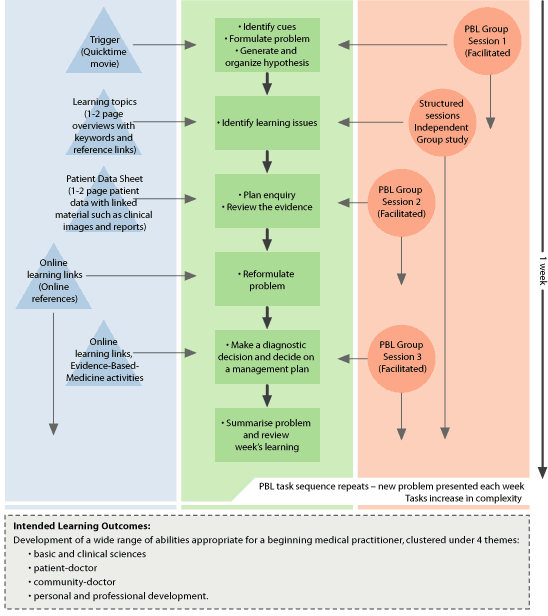|
WHAT THE STUDENTS DO
Curriculum Overview:
Problem-based learning (PBL) is a key educational approach
used throughout the Program. It underlies the curriculum structure
and learning experiences of students in a number of ways.
Not only does it integrate curriculum content through the
presentation of patient 'problems', but also provides the
context for students to develop their clinical reasoning skills;
and a springboard for collaborative self-directed learning.
In Years 1 and 2, online resources, delivered through the
Program’s intranet, support Program goals by giving students
access to the key tutorial materials needed to motivate and
support their clinical reasoning during the problem week,
both during their three, ninety-minute PBL tutorials each
week; and during their related self-directed learning. The
problem web page also provides specific, faculty-written starting
points for independent learning, as well as access to a wide
range of other learning opportunities. The design of these
web pages and the materials they present is specifically tailored
to meet the needs of a clinical reasoning model being used
by students to arrive at diagnostic and management decisions
during PBL tutorial activity and self-directed learning. During
their first two years, students also spend one day per week
in a clinical setting, which is related to the problem of
the week.
In the clinical years, the focus shifts toward full-time
learning in a clinical-practice setting. During Year 3, students
undertake a series of integrated clinical attachments in medicine
and surgery. In Year 4, students rotate through placements
that focus on child and adolescent health, perinatal and women’s
health, psychological medicine and community medicine. With
this shift in emphasis PBL tutorial activity is reduced in
favour of 'bed-side' learning. Nevertheless, PBL tutorials
retain an important position in the week’s activities,
providing an anchor for students’ exploration of key,
assessable curriculum content throughout Years 3 and 4. There
is also considerable opportunity for students to relate their
clinical experiences to tutorial discussions.
Modified PBL in Years 3 and 4
A different student is allocated the PBL case each week and,
in consultation with a clinical tutor, prepares to facilitate
the two ninety-minute PBL tutorials. The first tutorial focuses
on achieving a provisional/working diagnosis, and identifying
further learning issues – particularly those related
to management/treatment options. This ‘speeds-up’
the more protracted reasoning process of Years 1 and 2.
Students explore related learning issues, and return to the
final tutorial for a concentrated discussion of treatment
options, and to make a decision regarding the most appropriate
management of the case.
An online Clinical Reasoning Guide was developed to support
this changed PBL process, and to help students in their new
role as a PBL facilitator. The Guide is designed to ‘scaffold’
students’ clinical reasoning processes and assist them
to engage in a reflective dialogue about the clinical aspects
of the PBL cases with their clinical tutors. The Guide is
used by the student facilitator to individually reason through
the PBL case, in preparation for conducting the two PBL tutorials
– i.e. guiding the remainder of the group’s collaborative
reasoning through the same case.
More information about this specific online tool can be found
at:
http://www.medfac.usyd.edu.au/divisions/info/dme-hk-paper.pdf
(PDF)
Core learning and subject matter is integrated into this
weekly case-based focus.
SIGNIFICANCE OF ORDER
The PBL approach is developed over the course of the 4 year
program:
Years 1 and 2:
- 68 integrated PBL cases.
- 3 x 90 minute tutorials per week.
- Faculty tutor/facilitator.
- Basic mechanisms and evidence base.
- Primarily diagnosis plus some management.
Years 3 and 4:
- 28 PBL cases Year 3; 23 in Year 4.
- Students facilitate PBL tutorials, clinical tutor acting
as guide.
- Increased emphasis on clinical experience.
- Clinical attachments/rotations.
- Increased emphasis on self directed learning.
- Increased sophistication in application of Evidence Based
Medicine principles.
CRITICAL ACTIVITIES
Required:
Active participation in PBL sessions.
Optional:
Attendance at structured sessions.
Flexible:
Independent learning strategies.
|
